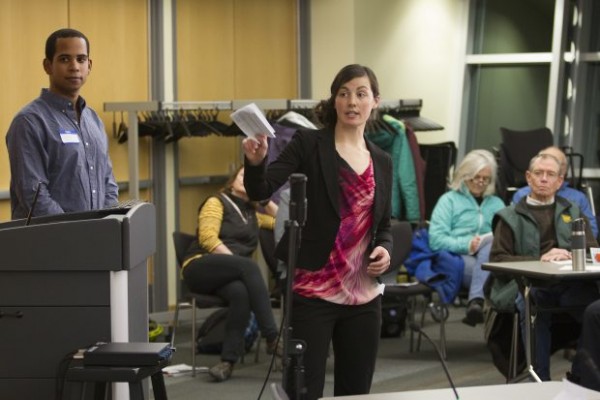Environment & Society class tackles public process on proposed Northern Access Route into U-Med District
by Kathleen McCoy |

University of Alaska Anchorage students Ryan A. Hunte, on the left, and Tara Harrington present information at the Rock the Road event in the Consortium Library on the UAA campus in Anchorage, Alaska Tuesday, Nov. 18, 2014. (Photo by Philip Hall/University of Alaska Anchorage)
When about 100 people gathered Tuesday night in UAA's Consortium Library to hear college students give an overview of the proposed Northern Access Route, it was more than a public information session. It was homework.
Eighteen undergraduates in an Environmental Planning and Problem Solving class owed their professors, Shannon Donovan and Jamie Trammell, a service-learning project with a big community-engagement element. What better choice than this challenging road project that could link Bragaw and Elmore roads through university lands.
Many in the audience assumed the road was a "done deal." A major goal for the students was explaining why it wasn't. Indeed, their professor noted that an overwhelming community presumption that the road issue was already settled could trigger more public outreach as it progresses.
The big argument for the new short connector is safety and access into the U-Med District, congested daily with arriving university students and employees as well as nurses, doctors and patients headed to area hospitals. As the students demonstrated in their overview, the roads are over capacity and safety is a concern. Key stakeholders in the area, from the universities to the hospitals, have all signed on to support a road development.
On the other side, the road as currently conceived would traverse wetlands. The wooded area is popular for walkers and skiers and as nearby green space for local neighborhoods.
With the U.S. Army Corps of Engineers as project managers, a wetlands permit would trigger NEPA, the National Environmental Policy Act of 1969. It requires any impact to the environment be clearly spelled out and involve extensive public notice and feedback. NEPA was signed into law by President Richard Nixon to "encourage productive and enjoyable harmony between man and his environment."
Donovan's class immerses Environment & Society majors in NEPA, designed to ensure that environmental concerns are weighted equally along with all other factors that go into development decisions.
The class and the major are new, about five years old. They were conceived as a way to prepare students for environmental planning in the context of Alaska, primarily a resource extraction state.
"We really took this very practical view of how we could make a degree program that would provide something of value to the state," said Dorn Van Dommelen, a geography professor and chair of the department. "This is not a 'greenie' degree they come to because they want to save the earth."
Rather than passing judgment on the nature of development and growth, Van Dommelen says, the major aims "to produce well-educated graduates possessing the technical skills needed to make mature, prudent decisions about how we use our resources."
Besides, he asks rhetorically, isn't it better to have Alaskans engaged in environmental assessment who have training in it and acquired that training at an Alaska school? Rather than having outsiders make that same evaluation?
For her part, Donovon stresses that students leaving with an Environment & Society degree shouldn't be thinking of the environment as the natural world versus the built world. "Humans are part of the environment, not outside it," she says. "So how do we begin to manage our environment with humans as a part of it?"
The class, major and department are all housed within the College of Arts and Sciences. "We have a strong value in liberal education," Van Dommelen said. "We believe that the modern university does more than just give jobs skills. It also gives these critical thinking skills."
But to make sure students come out of college ready for the work world, program creators sought out field professionals to ascertain the skills students need for success. Coursework includes an intense focus on fieldwork and lab skills.
"We really tried to create a degree program to produce liberally educated citizens," Van Dommelen said, "and at the same time give specific skill sets needed in the professional context."
The size of Tuesday night's crowd was a good indicator of interest in the road project. Students and citizens alike stayed well over two hours-through a lengthy panel discussion on the road project and a short workshop on writing effective public comments.
Students promised the crowd they'd update their "Rock the Road" Facebook page with the evening's PowerPoints as well as notice of upcoming road project developments.
A version of this story by Kathleen McCoy appeared Sunday, Nov. 23, 2014 Alaska Dispatch News.
 "Environment & Society class tackles public process on proposed Northern Access Route
into U-Med District" is licensed under a Creative Commons Attribution-NonCommercial 4.0 International License.
"Environment & Society class tackles public process on proposed Northern Access Route
into U-Med District" is licensed under a Creative Commons Attribution-NonCommercial 4.0 International License.














